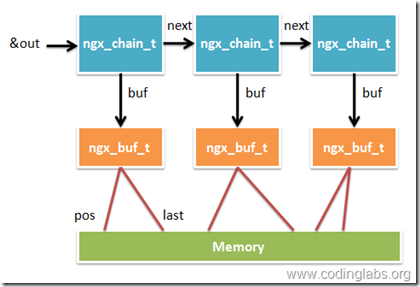本文主要基于
http://www.codinglabs.org/html/intro-of-nginx-module-development.html
和
http://www.evanmiller.org/nginx-modules-guide.html#compiling
的学习些的
nginx模块要负责三种角色
handler:接收请求+产生Output
filters:处理hander产生的output
load-balancer:负载均衡,选择一个后端server发送请求(如果把nginx当做负载均衡服务器的话,这个角色必须实现)
nginx内部流程(非常重要)
图片讲解:
英文讲解:
Client sends HTTP request → Nginx chooses the appropriate handler based on the location config → (if applicable) load-balancer picks a backend server → Handler does its thing and passes each output buffer to the first filter → First filter passes the output to the second filter → second to third → third to fourth → etc. → Final response sent to client
中文讲解:
客户端发送http请求 -- nginx根据配置文件conf中的location来确定由哪个handler处理-- handler执行完request返回output给filter--第一个filter处理output -- 第二个filter处理output--- … -- 生成Response
Nginx模块的几个数据结构
1 Module Configuration Struct(s) 模块配置结构
2 Module Directives 模块命令结构
3 The Module Context模块内容
3.1 create_loc_conf
3.2 merge_loc_conf
4 The Module Definition模块整合
5 Module Installation模块安装
1 模块配置结构:
这个结构的命名规则为ngx_http_[module-name]_[main|srv|loc]_conf_t。
main,srv,loc表示这个模块的作用范围是配置文件中的main/server/location三种范围(这个需要记住,后面会经常用到)
例子:
typedef struct {
ngx_str_t ed; //echo模块只有一个参数 比如 echo "hello"
} ngx_http_echo_loc_conf_t; //echo 模块
2 模块命令结构:
例子:
static ngx_command_t ngx_http_echo_commands[] = {
{ ngx_string("echo"), //命令名字
NGX_HTTP_LOC_CONF|NGX_CONF_TAKE1, //代表是local配置,带一个参数
ngx_http_echo, //组装模块配置结构
NGX_HTTP_LOC_CONF_OFFSET, //上面的组装模块配置获取完参数后存放到哪里?使用这个和下面的offset参数来进行定位
offsetof(ngx_http_echo_loc_conf_t, ed), //同上
NULL // Finally, post is just a pointer to other crap the module might need while it's reading the configuration. It's often NULL.我也没理解是什么意思。通常情况下设置为NULL
},
ngx_null_command //必须使用ngx_null_command作为commands的结束标记
};
注1:
ngx_http_echo 是组装模块配置结构的函数指针,有三个参数:
ngx_conf_t *cf 包含这个命令的所有参数
ngx_command_t *cmd 执行这个command命令结构的指针
void *conf 模块订制的配置结构
这个函数比较不好理解,其功能是把参数传到命令结构体中,并且把合适的值放入到模块配置结构中。我们称之为"setup function"。它会在命令运行的时候被调用。
nginx已经提供了几个现成的方法了:
ngx_conf_set_flag_slot
ngx_conf_set_str_slot
ngx_conf_set_num_slot
ngx_conf_set_size_slot
…
所以你可以这样定义cmd:
{ ngx_string("add_after_body"),
NGX_HTTP_MAIN_CONF|NGX_HTTP_SRV_CONF|NGX_HTTP_LOC_CONF|NGX_CONF_TAKE1,
ngx_conf_set_str_slot,
NGX_HTTP_LOC_CONF_OFFSET,
offsetof(ngx_http_addition_conf_t, after_body),
NULL },
也可以这样:
static ngx_command_t ngx_http_echo_commands[] = {
{ ngx_string("echo"),
NGX_HTTP_LOC_CONF|NGX_CONF_TAKE1,
ngx_http_echo,
NGX_HTTP_LOC_CONF_OFFSET,
offsetof(ngx_http_echo_loc_conf_t, ed),
NULL },
ngx_null_command
};
static char *
ngx_http_echo(ngx_conf_t *cf, ngx_command_t *cmd, void *conf)
{
ngx_http_core_loc_conf_t *clcf;
clcf = ngx_http_conf_get_module_loc_conf(cf, ngx_http_core_module);
clcf->handler = ngx_http_echo_handler; //这里指定了handler,那么就会使用新的handler进行处理
ngx_conf_set_str_slot(cf,cmd,conf); //这里还是使用系统的函数
return NGX_CONF_OK;
}
3 模块内容
static ngx_http_module_t ngx_http_circle_gif_module_ctx = {
NULL, /* preconfiguration */
NULL, /* postconfiguration 这里是放置filter的地方,在filter章节会说*/
NULL, /* create main configuration */
NULL, /* init main configuration */
NULL, /* create server configuration */
NULL, /* merge server configuration */
ngx_http_circle_gif_create_loc_conf, /* create location configuration */
ngx_http_circle_gif_merge_loc_conf /* merge location configuration */
};
模块的内容ngx_http_<module name>_module_ctx是为了定义各种钩子函数,就是nginx在各个不同的时期将会运行的函数。
一般的location只需要配置create location configuration(在创建location配置的时候运行)和merge location configuration(和server config如何合并,一般包含如果配置有错误的话应该抛出异常)
这两个函数的例子:(来自https://github.com/evanmiller/nginx_circle_gif/)
static void *
ngx_http_circle_gif_create_loc_conf(ngx_conf_t *cf)
{
ngx_http_circle_gif_loc_conf_t *conf;
conf = ngx_pcalloc(cf->pool, sizeof(ngx_http_circle_gif_loc_conf_t));
if (conf == NULL) {
return NGX_CONF_ERROR;
}
conf->min_radius = NGX_CONF_UNSET_UINT; //对conf中的每个参数进行配置,min_redius和max_redius是nginx_circle_gif模块的配置结构的字段
conf->max_radius = NGX_CONF_UNSET_UINT;
return conf;
}
和
static char *
ngx_http_circle_gif_merge_loc_conf(ngx_conf_t *cf, void *parent, void *child)
{
ngx_http_circle_gif_loc_conf_t *prev = parent; //server的loc配置
ngx_http_circle_gif_loc_conf_t *conf = child; // 自己的loca配置
ngx_conf_merge_uint_value(conf->min_radius, prev->min_radius, 10);
ngx_conf_merge_uint_value(conf->max_radius, prev->max_radius, 20);
if (conf->min_radius < 1) {
ngx_conf_log_error(NGX_LOG_EMERG, cf, 0,
"min_radius must be equal or more than 1");
return NGX_CONF_ERROR; //这里负责抛出错误
}
if (conf->max_radius < conf->min_radius) {
ngx_conf_log_error(NGX_LOG_EMERG, cf, 0,
"max_radius must be equal or more than min_radius");
return NGX_CONF_ERROR; //这里负责抛出错误
}
return NGX_CONF_OK;
}
注1 : ngx_conf_merge_uint_value是nginx core中自带的函数
ngx_conf_merge_<data type>_value
ngx_conf_merge_uint_value(conf->min_radius, prev->min_radius, 10);的意思是:
如果设置了conf->min_redius的话使用conf->min_redius
如果没有设置conf->min_redius的话使用 prev->min_radius
如果两个都没有设置的话使用10
更多函数请看 core/ngx_conf_file.h
4 模块整合
ngx_module_t ngx_http_<module name>_module = {
NGX_MODULE_V1,
&ngx_http_<module name>_module_ctx, /* module context 模块内容 */
ngx_http_<module name>_commands, /* module directives 模块命令*/
NGX_HTTP_MODULE, /* module type 模块类型,HTTP模块,或者HTTPS*/
NULL, /* init master */
NULL, /* init module */
NULL, /* init process */
NULL, /* init thread */
NULL, /* exit thread */
NULL, /* exit process */
NULL, /* exit master */
NGX_MODULE_V1_PADDING
};
5 模块安装
模块安装文件的编写依赖于这个模块是handler,filter还是load-balancer的工作角色
下面开始是Handler,filter,load-balancer的编写和安装
1 Handler安装
还记得在模块命令的时候有设置handler的语句吗?
clcf->handler = ngx_http_echo_handler;
这个语句就是handler的安装
2 Handler编写
Handler的执行有四部:
读入模块配置
处理功能业务
产生HTTP header
产生HTTP body
读入模块配置
例子:
static ngx_int_t
ngx_http_circle_gif_handler(ngx_http_request_t *r)
{
ngx_http_circle_gif_loc_conf_t *circle_gif_config;
circle_gif_config = ngx_http_get_module_loc_conf(r, ngx_http_circle_gif_module);
...
就是使用nginx已经有的函数ngx_http_get_module_loc_conf,第一个参数是当前请求,第二个参数是前面写好的模块
处理功能业务
这个部分是我们要模块处理的实际部分
用需求举例:
这个模块有个命令是 getRedisInfo 192.168.0.1 //获取redis的信息
那么这个功能业务就是(伪代码):
case cmd->opcode
{
"getRedisInfo" :
获取redis 的信息
}
这里应该把所有这个模块设置的命令的业务逻辑都写好
产生HTTP Header
例子:
r->headers_out.status = NGX_HTTP_OK;
r->headers_out.content_length_n = 100;
r->headers_out.content_type.len = sizeof("image/gif") - 1;
r->headers_out.content_type.data = (u_char *) "image/gif";
ngx_http_send_header(r);
产生HTTP Body
这个部分是最重要的一步
借用codingLabs的图讲解一下nginx的IO
handler是可以一次产生出一个输出,也可以产生出多个输出使用ngx_chain_t的链表来进行连接
struct ngx_chain_s {
ngx_buf_t *buf;
ngx_chain_t *next;
};
buf中有pos和last来代表out数据在内存中的位置,next是代表下一个ngx_chain_t
下面来说一下只有一个ngx_chain_t的设置
1 申明
ngx_buf_t *b;
ngx_chain_t out
2 设置buffer
b = ngx_pcalloc(r->pool, sizeof(ngx_buf_t));
if (b == NULL) {
ngx_log_error(NGX_LOG_ERR, r->connection->log, 0,
"Failed to allocate response buffer.");
return NGX_HTTP_INTERNAL_SERVER_ERROR;
}
b->pos = some_bytes; /* first position in memory of the data */
b->last = some_bytes + some_bytes_length; /* last position */
b->memory = 1; /* content is in read-only memory */
/* (i.e., filters should copy it rather than rewrite in place) */
b->last_buf = 1; /* there will be no more buffers in the request */
3 模块加入链表
out.buf = b;
out.next = NULL; //如果有下一个链表可以放到这里
4 返回
return ngx_http_output_filter(r, &out);
2 Filter的编写和安装
Filter作为过滤器又可以细分为两个过滤器: Header filters 和 body filters
Filter的安装
filter是在模块内容设置的时候加上的
例子:
static ngx_http_module_t ngx_http_chunked_filter_module_ctx = {
NULL, /* preconfiguration */
ngx_http_chunked_filter_init, /* postconfiguration */
...
};
static ngx_int_t
ngx_http_chunked_filter_init(ngx_conf_t *cf)
{
ngx_http_next_header_filter = ngx_http_top_header_filter;
ngx_http_top_header_filter = ngx_http_chunked_header_filter;
ngx_http_next_body_filter = ngx_http_top_body_filter;
ngx_http_top_body_filter = ngx_http_chunked_body_filter;
return NGX_OK;
}
注1: ngx_http_top_hreader_filter是什么意思呢?
当handler生成了response的时候,它调用了两个方法:ngx_http_output_filter和ngx_http_send_header
ngx_http_output_filter会调用ngx_http_top_body_filter
ngx_http_send_header会调用ngx_top_header_filter
Filter的编写
Header filters
分为三个部分:
是否操作这个handler的response
操作response
调用下一个filter
例子:
static
ngx_int_t ngx_http_not_modified_header_filter(ngx_http_request_t *r)
{
time_t if_modified_since;
if_modified_since = ngx_http_parse_time(r->headers_in.if_modified_since->value.data,
r->headers_in.if_modified_since->value.len);
/* step 1: decide whether to operate */
if (if_modified_since != NGX_ERROR &&
if_modified_since == r->headers_out.last_modified_time) {
/* step 2: operate on the header */
r->headers_out.status = NGX_HTTP_NOT_MODIFIED; //返回304
r->headers_out.content_type.len = 0; //长度设置为0
ngx_http_clear_content_length(r); //清空
ngx_http_clear_accept_ranges(r); //清空
}
/* step 3: call the next filter */
return ngx_http_next_header_filter(r);
}
Body filters
假设有个需求:在每个request后面插入"<l!-- Served by Nginx -->"
1 要找出最后chain的最后一个buf
ngx_chain_t *chain_link;
int chain_contains_last_buffer = 0;
for ( chain_link = in; chain_link != NULL; chain_link = chain_link->next ) {
if (chain_link->buf->last_buf)
chain_contains_last_buffer = 1;
}
2 创建一个新的buf
ngx_buf_t *b;
b = ngx_calloc_buf(r->pool);
if (b == NULL) {
return NGX_ERROR;
}
3 放数据在新buf上
b->pos = (u_char *) "<!-- Served by Nginx -->";
b->last = b->pos + sizeof("<!-- Served by Nginx -->") - 1;
4 把新buf放入一个新chain_t
ngx_chain_t *added_link; added_link = ngx_alloc_chain_link(r->pool); if (added_link == NULL) return NGX_ERROR; added_link->buf = b; added_link->next = NULL;5 把新的chain链接到原来的chain_link中
chain_link->next = added_link;
6 重新设置last_buf
chain_link->buf->last_buf = 0;
added_link->buf->last_buf = 1;
7 传给下一个filter
return ngx_http_next_body_filter(r, in);
最后一点是如何写和编译nginx模块
必须写两个文件config和ngx_http_<your module>_module.c
其中config会被./configure包含
ngx_addon_name=ngx_http_<your module>_module
HTTP_MODULES="$HTTP_MODULES ngx_http_<your module>_module"
NGX_ADDON_SRCS="$NGX_ADDON_SRCS $ngx_addon_dir/ngx_http_<your module>_module.c"
几乎都是填空
ngx_http_<your module>_module.c文件就是你的所有模块代码
编译nginx:
./configure --add-module=path/to/your/new/module/directory #这里是config放置的地方
----------------------
作者:yjf512(轩脉刃)
出处:http://www.cnblogs.com/yjf512/
本文版权归yjf512和cnBlog共有,欢迎转载,但未经作者同意必须保留此段声明

